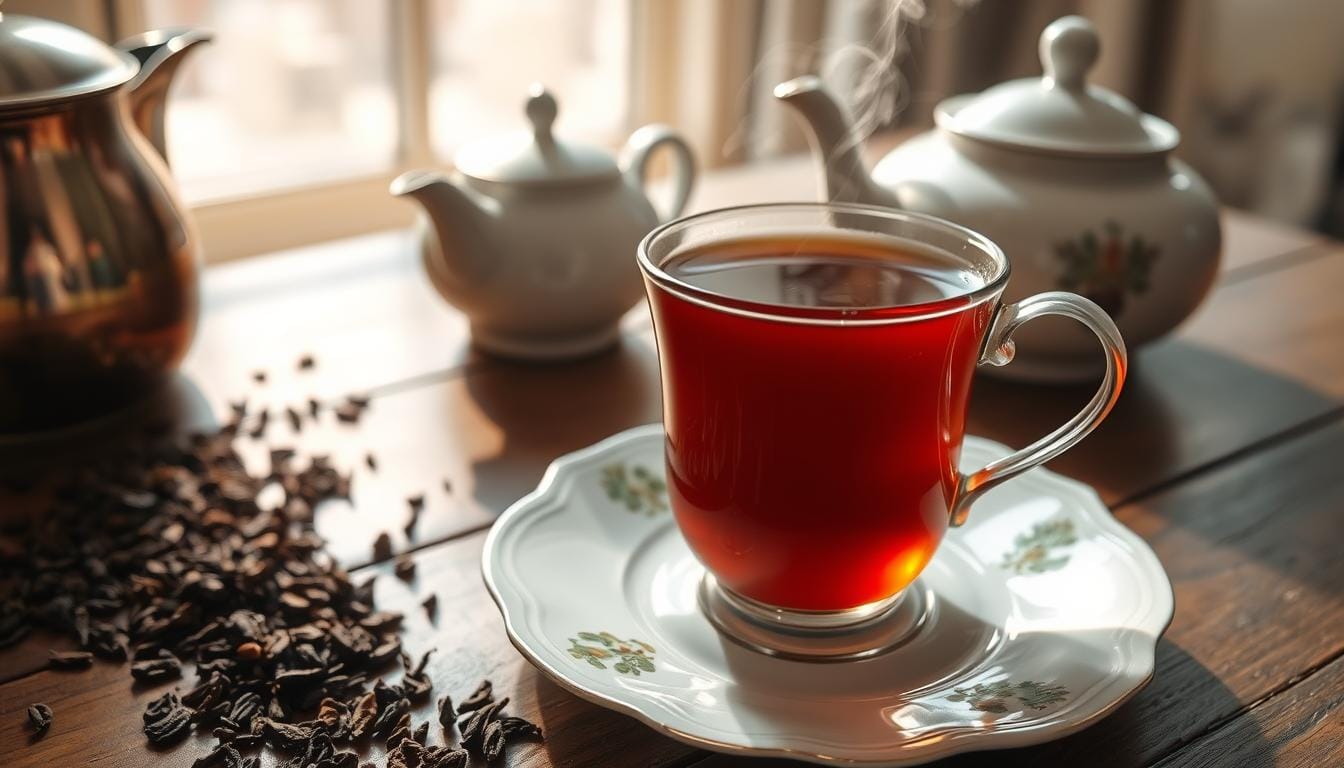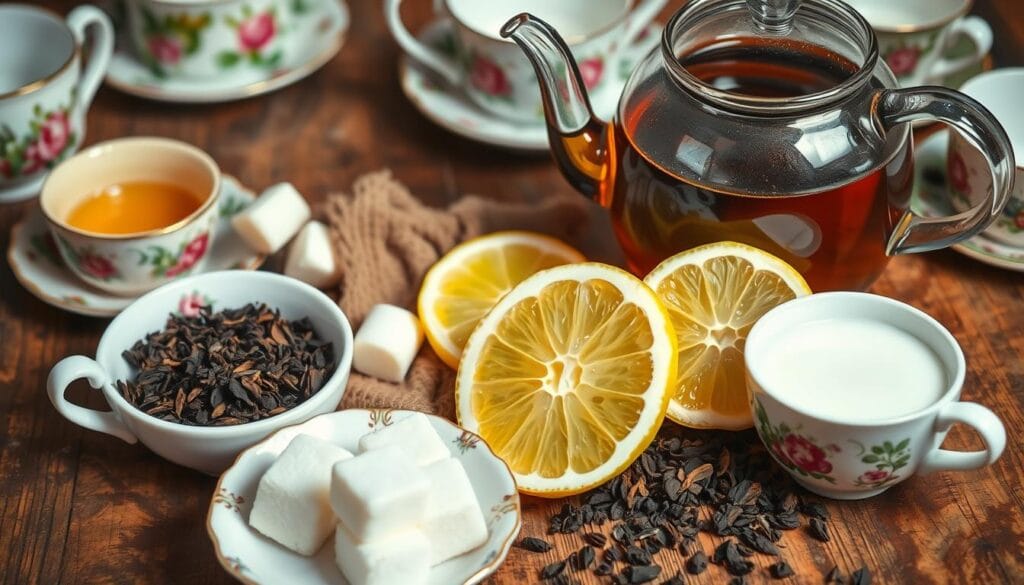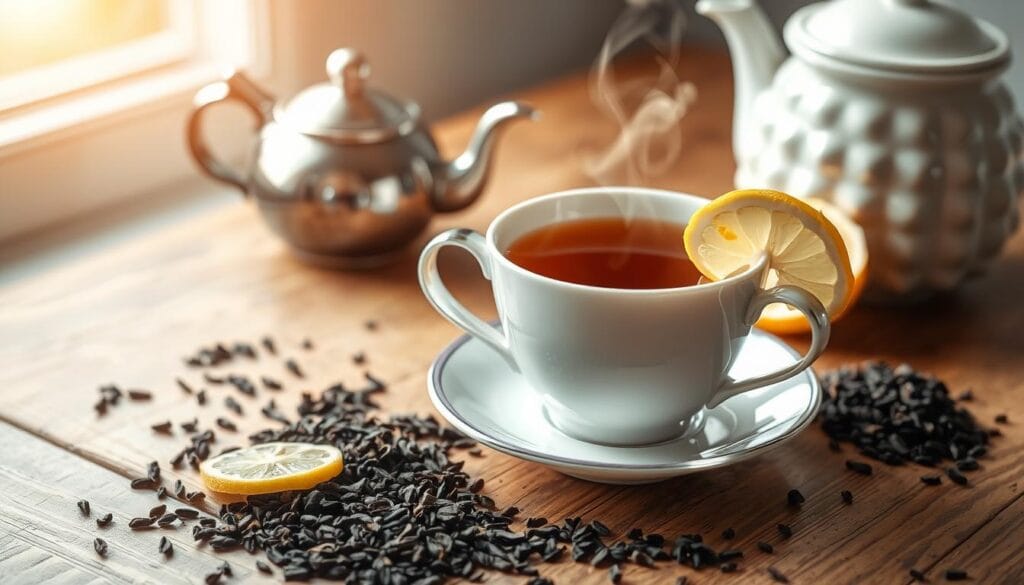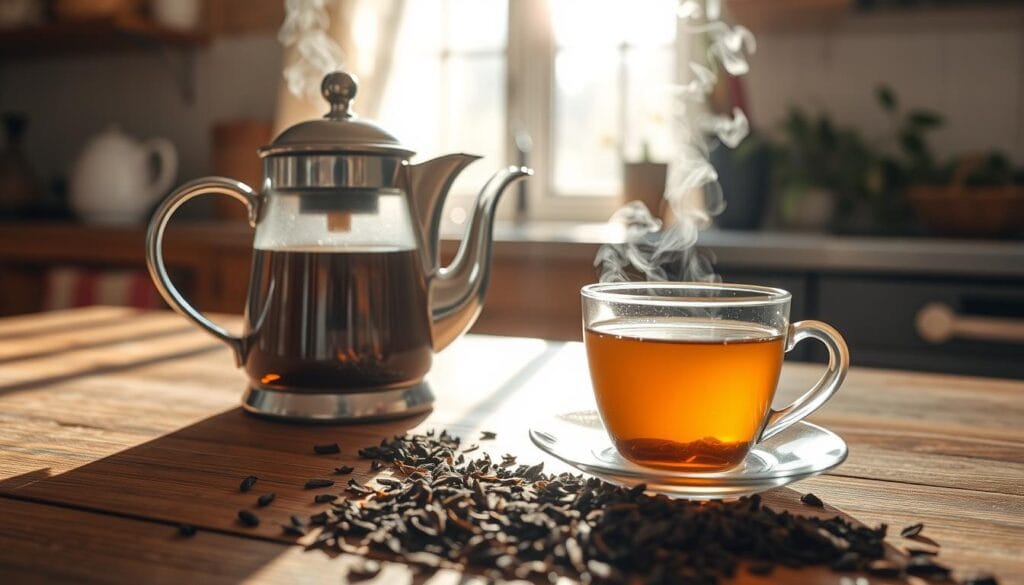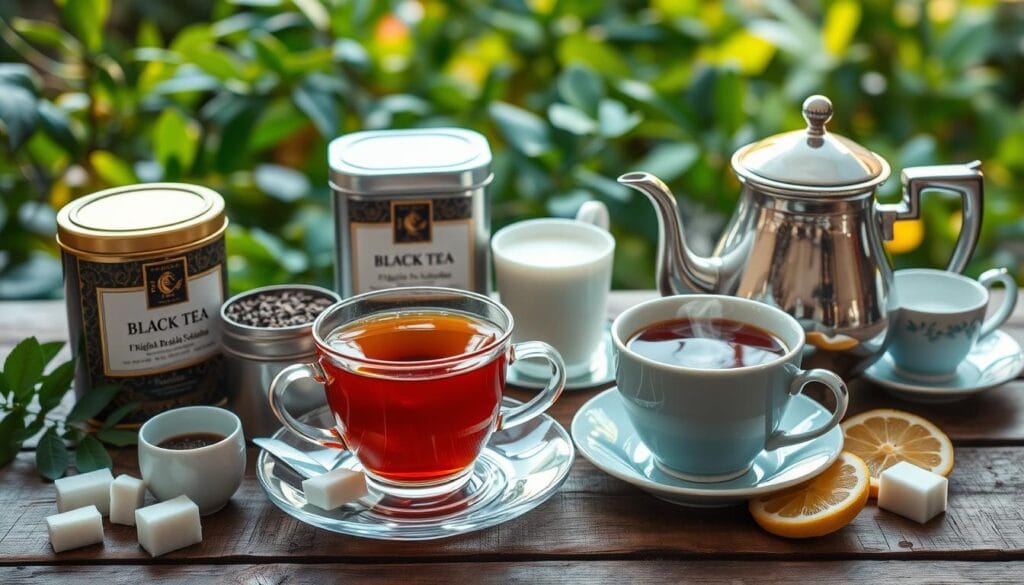As you take your first sip of morning tea, the strong flavors take you to a cozy British parlor. There, the tradition of English Breakfast tea has been loved for generations. It’s not just a caffeine boost. It’s a cultural touchstone that’s a big part of many people’s daily lives.
But what makes the perfect English Breakfast tea? This guide will explore the key ingredients, flavor, and health benefits. It aims to help you understand and enjoy the complexities of this beloved morning drink.
Introduction to English Breakfast Tea
English Breakfast tea is a favorite for many, loved for its strong taste and energy boost. It has a long history, starting in the 17th and 18th centuries. Tea importers in England mixed different Chinese teas, creating this classic blend.
In 1843, Richard Davies, an English immigrant in New York, made it famous. He named it “English Breakfast.”
A Brief History of English Breakfast Tea
The story of English B tea began with the British Empire’s growth. They took control of India and Sri Lanka, adding black teas to their blends. This made a strong, full-bodied tea for the English B.
Over time, the blend grew to include teas from China’s Keemun region and India’s Assam and Darjeeling districts.
The Popularity of English B Tea
Today, English Breakfast tea is loved everywhere. Its bold flavor is perfect with English breakfast foods like eggs, bacon, and toast. It also has a lot of caffeine, from 35 to 50 milligrams per cup.
Many enjoy it on its own or with milk and sugar. English B tea is a cherished part of many people’s daily routines.
“A proper cup of English breakfast tea is a brew to be savored, a moment of tranquility in the midst of a busy day.”
Key Ingredients in English Breakfast Tea
English B tea is known for its strong, full flavor. This comes from a mix of black tea types. The main ones are Assam, Ceylon, and Darjeeling black teas.
Black Tea Varieties Used
Assam black tea, from India, gives the tea a rich, malty taste. Ceylon black tea, from Sri Lanka, adds a bright and lively touch. Darjeeling black tea, from India, brings a subtle, aromatic flavor.
Premium English B blends might also include Kenyan black tea for depth. Chinese Keemun black tea adds to the aroma.
Other Natural Ingredients
- The mix of these top-quality black teas makes English B tea strong and full-bodied.
- Black tea has about half the caffeine of coffee. It releases caffeine slowly for alertness that lasts.
- Research shows black tea might help with blood pressure, weight, and some cancers.
| Tea Ingredient | Origin | Flavor Contribution |
|---|---|---|
| Assam Black Tea | Assam, India | Malty, robust |
| Ceylon Black Tea | Sri Lanka | Bright, lively |
| Darjeeling Black Tea | Darjeeling, India | Subtle, aromatic muscatel |
| Kenyan Black Tea | Kenya | Depth, complexity |
| Keemun Black Tea | China | Enhanced aroma |
The blend of these premium black teas makes English Breakfast tea unique and loved.
Flavor Profile of English Breakfast Tea
English Breakfast tea offers a bold, full-bodied taste, like a strong coffee. It has rich, malty notes with a hint of bitterness and a sweet finish. The aroma is strong and inviting, making you want to take a sip.
Compared to other B teas, English B is smoother. It has a mellow taste, unlike the bold Irish or Scottish teas. It’s comforting and satisfying, perfect for starting your day with a robust tea tasting experience.
Aromatic Characteristics
The aroma of English B tea is a big part of its charm. The tea’s robust tea flavor is reflected in its scent. It smells malty and full-bodied, with hints of earth, caramel, or chocolate.
It also has a subtle sweetness, with citrus or spice notes. This fragrance prepares you for the strong tea flavor that follows, making each sip a delight.
Tasting Notes
English Breakfast tea’s taste is bold and satisfying. Its flavor profile includes rich, malty undertones and a touch of bitterness. It has a smooth mouthfeel that’s comforting and satisfying.
The tea’s finish is slightly drying, leaving you wanting more. These tasting notes come together to make a well-rounded, distinctive tea that many enjoy.
“The robust, full-bodied flavor of English B tea is a true delight for the senses. Each sip is a harmonious blend of malty sweetness and subtle bitterness, creating a satisfying and invigorating experience.”
Nutritional Benefits of English Breakfast Tea
English Breakfast tea is more than just a tasty drink. It’s full of antioxidants and minerals that boost your health. Drinking it regularly can make you feel better overall.
Antioxidant Properties
English B tea is loaded with antioxidants like tannins, catechins, and polyphenols. These fight off harmful free radicals in your body. They help lower the risk of heart disease, cancer, and diabetes.
Potential Health Benefits
- Supports heart health: The flavonoids in English B tea may help improve circulation and lower cholesterol levels, reducing the risk of heart attacks and strokes.
- Enhances cognitive function: The L-theanine and caffeine in this tea can improve focus, memory, and alertness without the jitters associated with coffee.
- Promotes bone health: English B tea contains essential minerals like potassium and manganese, which are crucial for maintaining strong, resilient bones.
- Aids digestion: The polyphenols in this tea can nurture beneficial gut bacteria and inhibit the growth of harmful microbes, supporting overall digestive health.
Looking to boost your energy, strengthen your immune system, or just enjoy a tasty drink? English B tea is a great choice. It’s a simple way to get more tea benefits, antioxidants, and health benefits into your life.
Brewing Techniques for Optimal Flavor
Making the perfect cup of English B tea needs careful brewing. Use water at 205-212°F (96-100°C). Add 1 teaspoon of loose leaf tea or 1 tea bag per cup. Steep for 3-5 minutes for the best flavor.
For iced tea, follow the same steps. Cool the tea to room temperature before chilling it. Loose leaf tea often tastes better than tea bags. Try different steeping times to find your favorite flavor.
Recommended Water Temperature
The best water temperature for English B tea is 205-212°F (96-100°C). This temperature helps the tea leaves infuse the water fully. It brings out the rich, robust flavors of this classic tea.
Steeping Time Guidelines
- Steep for 3-5 minutes for a standard cup of English B tea.
- Steeping for up to 7 minutes makes the tea stronger and more intense.
- Don’t steep too long, as it can make the tea taste bitter and astringent.
| Steeping Time | Flavor Profile |
|---|---|
| 3 minutes | Mild, smooth flavor |
| 4-5 minutes | Robust, full-bodied taste |
| 6-7 minutes | Strong, intense flavor |
By following these guidelines, you can always make a perfect cup of tea. It will show off the unique flavors of English B tea.
“The secret to a perfect cup of English Breakfast tea lies in the precise temperature and steeping time.”
English Breakfast Tea Variations
There are many interesting variations of English B tea to try. If you’re sensitive to caffeine, decaf English B tea is a great choice. It has the same rich flavor as the traditional version but without the caffeine.
Herbal tea blends are another option for those who want to avoid caffeine. They use ingredients like rooibos and honeybush to give a similar taste to English B tea. These blends also include herbs and spices for extra flavor.
| Decaf English Breakfast Tea | Herbal English Breakfast Tea Blends |
|---|---|
| Retains the robust, full-bodied flavor of traditional English Breakfast tea | Caffeine-free ingredients like rooibos, honeybush, or aromatic herbs and spices |
| Specialized decaffeination process to remove caffeine | Aim to mimic the satisfying taste experience of English Breakfast tea |
| Ideal for those sensitive to caffeine or looking to reduce their intake | Provides a similar drinking experience without the stimulating effects of caffeine |
Whether you love the classic English B tea or want to try something new, there are plenty of options. These decaf tea and herbal tea blends are exciting ways to enjoy your tea time.
Pairing Suggestions for English Breakfast Tea
English Breakfast tea is great with many foods, from B to afternoon treats. It’s perfect for morning or afternoon, pairing well with different tastes and dishes.
Foods That Complement the Flavor
The strong taste of English B tea goes well with hearty B. Tie Guan Yin (Oolong Tea) is good with eggs and bacon on toast. It cuts through grease nicely.
Longjing (Green Tea) is great with eggs Benedict, and Yunnan (Black Tea) pairs well with Mexican eggs.
For a classic English B, try Tie Guan Yin (Oolong Tea) and Yunnan or Yingde (Black Tea). They match well with sausages, mushrooms, and tomatoes.
Best Time of Day to Enjoy It
English B tea is not just for morning. Its strong flavor is perfect for B, but also for an afternoon boost or with desserts. It goes well with both sweet and savory foods, making it great for any meal or snack.
| Tea Variety | Recommended Food Pairings |
|---|---|
| Tie Guan Yin (Oolong Tea) | Eggs and bacon, beef dishes, sweet cakes and caramel-based desserts |
| Longjing (Green Tea) | Eggs Benedict with ham, avocado toast, classic omelets |
| Yunnan (Black Tea) | Mexican-style eggs, red meat dishes |
| Yingde (Black Tea) | English breakfast with sausages, mushrooms, and tomatoes |
| Jasmine Tea | Fresh fruit, sweet pastries |
English B tea is a versatile and tasty choice for any time of day. Enjoy it with a hearty B or a light afternoon snack.
Choosing Quality English Breakfast Tea
When picking your English B tea, think about a few important things. The choice between loose leaf and tea bags greatly affects taste and experience.
Tips for Selecting Loose Leaf vs. Bags
For the best English B tea, choose loose leaf. Loose leaf teas taste richer and more complex than bagged ones. They have more space to unfurl and release their aroma.
Tea bags are handy for quick brews. But, make sure to pick high-quality ones. Look for brands that use real loose leaf tea, not just dust.
How to Read Tea Labels
When looking at loose leaf tea or tea bags, read the labels carefully. Good English B teas will say where they come from, like Keemun or Assam. They’ll also mention the specific places where the leaves were grown.
Check the tea’s freshness and smell. Fresh, aromatic leaves mean better quality and taste.
“The secret to a perfect cup of English Breakfast tea lies in selecting high-quality leaves and brewing them with care.”
Conclusion: Enjoying English Breakfast Tea
To fully enjoy your English B tea, try different brewing times and temperatures. Some like it plain, while others add milk or lemon. You can also sweeten it with sugar or honey to taste.
Making the Most of Your Cup
Creating your own tea ritual can make it even better. Enjoy it in the morning or as an afternoon treat. English B tea is comforting and flavorful.
Experimenting with Add-Ins
Exploring milk tea, tea enjoyment, and tea rituals means trying new things. The classic milk and sugar combo is great, but you might find new favorites. Try lemon or honey for a twist. This tea lets you make it your own.
FAQ
What is in an English Breakfast tea?
English Breakfast tea is a mix of black teas from India, Sri Lanka, and Kenya. It’s known for its strong taste to start the day. The blend includes Assam, Darjeeling, and Ceylon teas, with some adding Chinese Keemun.
What is the history of English Breakfast tea?
English Breakfast tea started in the 17th and 18th centuries in England. Tea importers mixed various Chinese teas. Richard Davies, an English immigrant in New York City, named it “English Breakfast” in 1843. The blend later included teas from British colonies in India and Sri Lanka.
What are the key ingredients in English Breakfast tea?
English Breakfast tea is made of Assam, Ceylon, and Darjeeling black teas. Assam adds a malty taste, Ceylon brings brightness, and Darjeeling has a subtle muscatel flavor. Some blends also include Kenyan black teas for depth or Chinese Keemun for aroma.
What is the flavor profile of English Breakfast tea?
English Breakfast tea tastes like coffee but is smoother. It has rich, malty, bitter, and sweet notes. The aroma is strong and inviting. It’s bold but milder than Irish or Scottish breakfast teas.
What are the health benefits of English Breakfast tea?
English Breakfast tea has antioxidants like tannins, catechins, and polyphenols. It’s full of minerals like potassium and manganese. These may help with bone and heart health. It has 30-50 mg of caffeine per cup, giving energy. L-theanine in black tea can slow caffeine absorption, reducing jitters and crashes.
How do I brew the perfect cup of English Breakfast tea?
For the best English Breakfast tea, heat water to 205-212°F (96-100°C). Use 1 teaspoon of loose leaf tea or 1 tea bag per cup. Steep for 3-5 minutes for a stronger flavor. For iced tea, brew as usual and cool before refrigerating. Loose leaf tea often tastes better than tea bags.
What are the variations of English Breakfast tea?
Decaffeinated English Breakfast tea is for those who can’t handle caffeine. Herbal variations mimic the robust flavor of traditional English B tea but are caffeine-free. These alternatives offer a similar taste without caffeine’s effects.
What foods pair well with English Breakfast tea?
English Breakfast tea goes well with breakfast foods like eggs, bacon, and toast. It’s also great with pastries and scones. Enjoy it in the morning or any time of day. Its strong flavor suits both sweet and savory foods, making it versatile.
How do I choose quality English Breakfast tea?
Choose loose leaf English B tea for better flavor. Look for teas that list their origin and blend components. High-quality blends mention specific estates or regions. Check labels for the tea’s composition and any extra ingredients. Fresh, aromatic tea leaves are a sign of quality.

